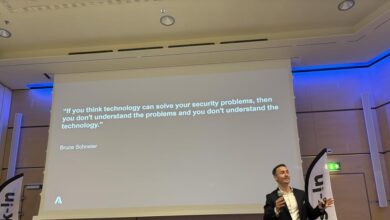On the Future of Cybersecurity in Hybrid Cloud Environments

Artificial Intelligence & Machine Learning
,
Cloud Security
,
Next-Generation Technologies & Secure Development
An Interview with Gigamon’s Chief Security Officer, Chaim Mazal
Chief Information Security Officers (CISOs) face unprecedented challenges in their efforts to protect their organizations against a rising tide of increasingly sophisticated cyberthreats.
To help them manage the risks and improve cybersecurity, especially in hybrid cloud environments, we sat down with Chaim Mazal, Chief Security Officer at Gigamon, who offered a deep dive into the intricacies of securing hybrid cloud environments, along with the importance of visibility, and how CISOs and security leaders keep up evolving cybersecurity requirements.
Q: What are the biggest challenges CISOs face these days?
Chaim Mazal: The complexity of the environments they must secure has significantly increased. We are no longer dealing with just a single data center or cloud environment. It’s now a mix of multiple cloud environments, hybrid setups, and on-premise infrastructures. This complexity makes comprehensive security extremely challenging. Additionally, the regulatory landscape has grown more stringent, with regulations such as GDPR and CCPA adding to the complexity. Lastly, the talent shortage in cybersecurity is another hurdle to overcome. There simply aren’t enough qualified professionals to fill the growing number of positions available.
Q: How is Gigamon addressing these challenges?
Chaim Mazal: At Gigamon, we focus on providing comprehensive visibility or what we call deep observability across all environments — on-premise, cloud, and hybrid. This depth of visibility allows our customers to understand their environments better and identify potential threats earlier. We efficiently deliver network-derived intelligence to various security tools, bringing the complete picture into focus while making the integration process seamless and efficient. This approach helps reduce complexity and improves the overall security posture of our customers.
Q: What role does automation play in enhancing cybersecurity?
Chaim Mazal: Automation is crucial in managing the vast amount of data we process daily. It enables us to keep up with the pace of change today in cybersecurity. Automation helps reduce the number of false positives by mechanizing the initial triage of alerts, allowing analysts to focus on genuine threats. This not only improves efficiency but also enhances the accuracy of threat detection and response.
Q: What proactive measures are essential to help CISOs stay ahead of breaches?
Chaim Mazal: Continuous threat modeling is key. Organizations need dedicated teams to continuously map the threat landscape across their entire infrastructure, including both production and corporate environments. Regularly updating threat models and performing continuous penetration testing are essential. Also, having a robust incident response plan in place is critical to reacting in real-time when an incident occurs.
Q: How can organizations ensure their security measures keep up with rapid technological changes?
Chaim Mazal: Investing in your security team is the first step. Security should not be an afterthought in budget allocations. Providing the right tools and resources to your team is essential. Organizations should also ensure that their security operations are integrated with their development teams to embed security into the development lifecycle. They need to constantly evaluate and update their toolsets to keep pace with technological advances as well.
Q: What trends or technologies will shape the future of cybersecurity?
Chaim Mazal: Artificial Intelligence (AI) and Machine Learning (ML) are going to be game-changers. The sheer volume of data we need to process necessitates the use of AI and ML to make real-time decisions. Additionally, Zero Trust Network Architecture is becoming increasingly important as organizations move to hybrid cloud environments. This approach ensures that security is maintained regardless of where data resides.
Q: What makes visibility into encrypted traffic important, and how does Gigamon enhance visibility?
Chaim Mazal: Visibility into encrypted traffic is critical because a significant amount of malware today hides in encrypted traffic. Traditional security tools often lack the ability to effectively inspect encrypted traffic, leaving organizations vulnerable. Gigamon Precryption™ technology provides unobscured visibility into encrypted traffic across virtual and containerized workloads, enabling advanced threat detection and response. This is essential for maintaining a robust security posture in hybrid cloud environments.
Q: How does the integration of network-derived intelligence with traditional security tools benefit organizations?
Chaim Mazal: Network-derived intelligence offers real-time insights into network traffic patterns, which are crucial for detecting anomalies and potential threats. When integrated with traditional security tools, this intelligence improves threat detection by providing a comprehensive view of the network. It allows organizations to detect and mitigate threats that conventional tools might miss, which as a result improves overall security effectiveness. This integration provides organizations with deep observability into all data in motion across their hybrid cloud environment.
Q: What strategic advice would you give to CISOs seeking to enhance threat detection capabilities?
Chaim Mazal: CISOs should prioritize gaining deep observability into their network traffic, both encrypted and unencrypted. Investing in advanced threat detection tools that leverage AI and ML is also important. Additionally, fostering a culture of continuous learning and staying updated with the latest threat intelligence will make an enormous difference. Collaboration and knowledge-sharing in the cybersecurity community can provide valuable insights and strategies to help them stay ahead of potential threats.
Q: How should organizations approach the implementation of Zero Trust architectures?
Chaim Mazal: Deploying a Zero Trust architecture requires careful planning and a phased approach. Organizations should start by segmenting their networks and implementing strict access controls. It’s essential to continuously monitor and validate all network activities. Practical steps include integrating endpoint security tools and ensuring that security measures are user-friendly to avoid disrupting operations. Overcoming barriers to Zero Trust also requires addressing cultural resistance and providing adequate training to ensure a smooth transition.
Q: How is the role of CISOs evolving?
Chaim Mazal: CISOs are becoming more strategic. They have increased responsibilities in risk management and communication with the board. CISOs need to effectively articulate those cybersecurity risks and strategies to the executive team and the board. Ensuring direct reporting lines to the CEO and board can enhance communication and provide better oversight. This evolution is essential for aligning cybersecurity initiatives with overall business objectives and ensuring a proactive security posture.
Q: How can organizations balance security and privacy concerns while inspecting encrypted traffic?
Chaim Mazal: Implementing robust data anonymization techniques and ensuring compliance with regulatory standards can help organizations better balance security and privacy issues. Organizations should focus on abstracting individual identities and analyzing behavior patterns instead. Transparency in how data is processed and ensuring that privacy-preserving principles are adhered to is crucial. Continuous dialogue with stakeholders, including privacy advocates, can also help organizations refine how best to maintain this balance.
Q: What practical implications do new decryption technologies have for daily cybersecurity operations?
Chaim Mazal: New decryption technologies simplify the process of gaining visibility into encrypted traffic, which is critical for threat detection and response. These technologies reduce manual efforts and overhead costs associated with traditional decryption methods, making it easier for security teams to monitor encrypted traffic in real-time. Enhanced visibility allows for quicker identification and mitigation of threats, ultimately strengthening the organization’s security posture.
Q: What are some common misconceptions about threat prevention in hybrid cloud environments?
Chaim Mazal: One common misconception is that logs alone are sufficient for threat detection and prevention. While logs are important, they are not foolproof and can be tampered with. Relying solely on logs can leave organizations vulnerable. A more effective approach is to combine log data with packet-level network data for a comprehensive view. We call this combination deep observability, and it provides a more accurate picture of network activities and helps in validating the integrity of the data.
Q: What advice do you have for CISOs facing the challenges of securing hybrid cloud environments?
Chaim Mazal: CISOs should focus on gaining comprehensive visibility or deep observability across all cloud and on-premise environments. Implementing advanced threat detection tools and ensuring seamless integration of security tools will help. Continuous threat modeling and regular penetration testing can also help them identify and mitigate vulnerabilities. Finally, fostering a culture of security awareness and investing in ongoing security training are essential for staying ahead of emerging threats.
Mazal drives home the importance of visibility, automation, and proactive measures in improving cybersecurity in hybrid cloud environments. As threats evolve, CISOs and security leaders must stay vigilant and adaptive to effectively combat increasingly sophisticated cyber threats.



